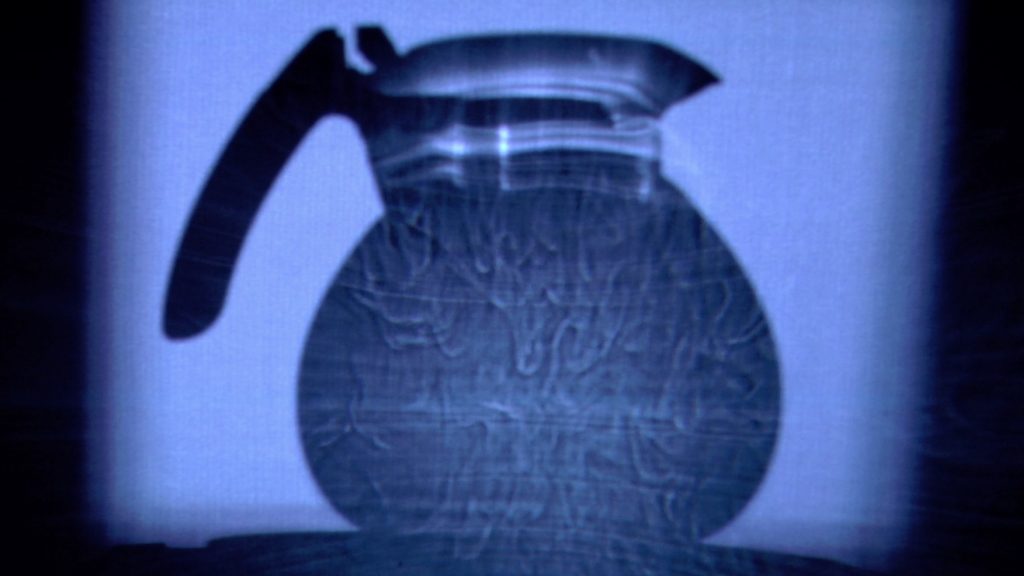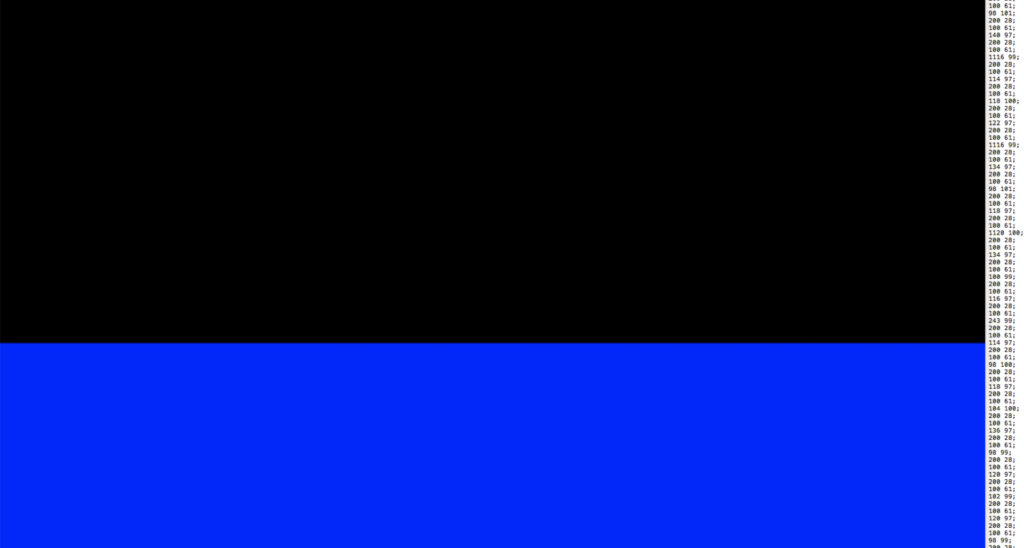Monday July 11, 7:30pm
Barbara Lattanzi
A Teakettle’s Thermal Beings
Live Performance and other works
As part of “Imageless” Series
Artist in person— Q&A follows

Microscope is very pleased to present “A Teakettle’s Thermal Beings,” an evening of live performance and video works by Barbara Lattanzi, made between 1988 and 2014. The event is taking place as part of our series of “Imageless Film” performances in connection and collaboration with the “Imageless Films” series at Anthology Film Archives.
Lattanzi describes her performance A Teakettle’s Thermal Beings as a “material computation without a computer.” In this work, a cast shadow of a teakettle — created through a projection of a single blue video frame through a glass container filled with water on a hotplate — manifests “the self-organizing behavior of water forming structural entities,” revealing the complete transformative process of boiling water from static liquid to dispersing vapor. The artist will perform the piece for the first time since its debut in 2014 at Hallwalls in Buffalo, NY.
Two earlier “imageless” videos by the artist, will precede the roughly 28-minute performance. In “Soma” (1988), a work in which the lack of imagery is offset by the use of text, Lattanzi focuses on bodily functions and processes. Composed entirely with black and white intertitles created on a 1988 Chyron analog/digital text generator — and accompanied by the soundtrack of F. W. Murnau’s 1922 film “Nosferatu” — the work intercuts descriptions of symptoms of illness or other ailments from three sources: a set of highly vivid archaic records; modern, more analytical medical texts; and various body-related jokes. Lattanzi says “these language-encodings of symptoms — Soma’s micro-narratives of pain — must be injured in their turn by the lexical confusion of jokes.”
In “Indirect,” Lattanzi considers the properties of analog and digital video and asks whether through the introduction of turbulent processes it is possible to interfere with and deteriorate the more stable digital frame. Whereas the disruption of an analog frame can be achieved electronically through feedback, Lattanzi uses an indirect method to achieve results in the digital realm. She, in effect, harnesses the blowing wind using computer-vision techniques to map the wind’s changes onto the “moving fields of color” imagery.
Barbara Lattanzi will be in attendance and a Q&A with the artist will follow the performance.General Admission $10
Member admission $8
Please note: Masks are required for entry to our events at this time.
_
Barbara Lattanzi’s art practice has roots in Chicago. There she attended the School of the Art Institute, studying with Imagist painter Ray Yoshida and going to cinema lectures of Stan Brakhage. Later she studied with Hollis Frampton and Tony Conrad at Center for Media Study (Buffalo, NY). For many years she participated actively in Buffalo’s artist-run organizations and networks. These included Hallwalls Gallery, CEPA, Squeaky Wheel, 8mm News Collective and Media Coalition for Reproductive Rights. From 2006 to 2020, she was a professor of expanded media at the New York State College of Ceramics, Alfred University. Lattanzi has produced work in a wide range of media -films, videos, installations, Internet art, custom software, and computational animation. Exhibitions of her work include Whitney Museum of American Art, Block Museum of Art(Northwestern University), XCÈNTRIC 2020 (Barcelona), and many others. She currently resides in the small village of Alfred, in New York’s geographical Southern Tier.
Program:
A Teakettle’s Thermal Beings
Electric burner, heatable glass container, half-gallon of water, focused beam of light, projection screen, dimensions variable, 2014, duration variable: approx. 28 minutes
“A Teakettle’s Thermal Beings” coaxes into visibility a process of material computation without a computer. In the sinuous tangle of projective shadows, an observable process takes place. The emergent thermal beings not only compute a circular (convecting) current, but also briefly maintain this rotational circuit in a rhythmic equilibrium. Poised between liquid and gas states, the thermal beings form a coherent structure for an intense moment on the edge of chaos.
Soma
HD Video (digital transfer from analog video), Sound, 1988, 7 minutes
“Soma” presents an archaic language of bodily symptoms. In comparison with contemporary medical symptomatology more dependent on quantitative measures, this archaic language of the human body and its suffering seems equally, but more qualitatively, observant. “Soma” goes further, however. These language-encodings of symptoms – Soma’s micro-narratives of pain – must be injured in their turn by the lexical confusion of jokes. The video, “Soma”, was made in 1988 on a Chyron text generator, a hybrid analog-digital device commonly used at that time in television studios and public access cable facilities such as the one in Lockport, New York, where I was able to try one out. “Soma” was originally to be one of a series based on 19th-century medical symptomatology, but this is the only one that was completed. Except for the titles that appear at the end, this digital version was made from a VHS dub from the original 3/4-inch tape, so it is dense with the noisy grain of analog video. For the digital HD transfer (2014) I added titles at the end of the original video in order to cite my sources for the soundtrack and for the texts that make up the body of this work.
Indirect
Computational video, Silent, 2015, 15 minutes
Can turbulent processes be used to affect the stability of video’s digital frame? In comparison, injecting such a problem into an analog video signal is more clear-cut. That is, one can use electronic feedback to affect the image raster (its “frame”), collapsing the entire image-field in an elaborate morphogenetic display. However, with digital video, the destabilizing (and deterritorializing) of the frame is very indirect. Thus, instead of an electronic signal, “Indirect” uses a dataset of a turbulent phenomenon – in this case, the blowing wind. These changes in wind intensity, the continual flux of gusts and calm, are derived from a common computer-vision technique. The data output of this computer-vision analysis maps the wind’s turbulence onto moving fields of color.
WARNING: do not watch this video if you are sensitive to flickering light.


